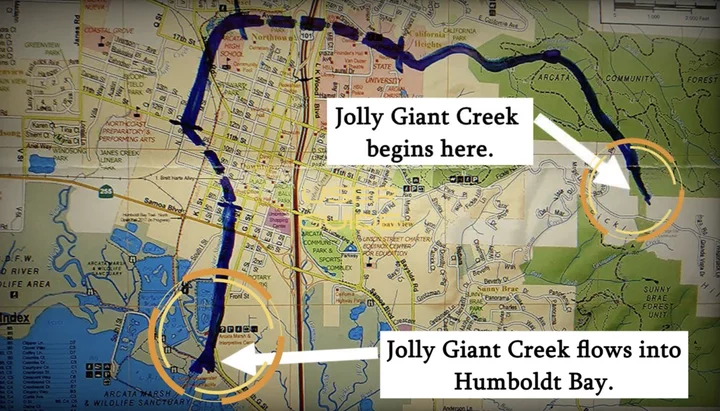OBITUARY: Carol Jean Swain, 1939-2023
LoCO Staff / Friday, May 12, 2023 @ 6:56 a.m. / Obits
Carol Jean Swain, 83, went to be with her Lord and Savior, Jesus Christ on March
29, 2023.
She was born on December 9, 1939, to Forrest Gurnsey and Ila May Bandy Gurnsey. Carol had many creative talents. She painted many beautiful paintings on canvas and old saw blades. She enjoyed crocheting and knitting, making gifts for her friends and family. The family always looked forward to Grandma Carol’s hand made slippers, wash cloths, afghan blankets and scarves. She loved traveling with her husband and little doggies in their RV. They were always adventurous in their RV traveling, trying out new places and parks and meeting new people. One of her favorite places to RV was close to home, at the Church Camp in Richardson’s Grove where they enjoyed visiting and helping their friends Bruce and Theresa. Carol always loved and enjoyed attending ladies lunch and bible study. She was a collector of butterfly trinkets and jewelry. She loved to read, but unfortunately, the last six months made that a difficult thing to do so she turned to watching her old cowboy movies. She was loved so much and is missed beyond measure.
Carol is survived by her husband Gerald “Steve” Swain, Son Forrest Johnson (Judy), Step-sons Gerald Swain (Jessica), Scott Swain (Taj), Grandchildren- Shayla Verbich (Mike), Shaun Bagley, Linnea Haycock (Tim), Meagan Johnson, Seth Johnson, Christopher Swain, Cassondra Swain-Stoner, Kenny Swain (Tessa), Shelsey McDonald, Dustin Swain, Tyler Swain, Shyanne Swain. Great-Grandchildren- Dylan, Braydan, Kolby, Dusty, Taylin, Lucus, Ariana, Aubree, Meagan, Connor, Rachael, Cash, Koda, Zeipher, Kinsley, Remington and Brody. Nephews Michael Murrish (Gina) and Stephen Murrish (Becky), Niece Dawna Kyber (Tim). Doggies, Heidi, Toby and Toto and her feathered friend Beamer.
She is preceded in death by her parents Forrest and Ila May Gurnsey, her Sister and Brother-in-law Betty Murrish and Don Murrish, Son Franklin Johnson, Step-Daughter Sherry McDonald, Step-Son Donald Swain, Nephew Curtis Murrish, Granddaughter Crystal, Grandsons, Brandon Swain and Steven Swain. A memorial service will be held on Saturday, May 20, 2023 at 1:00p.m. at Sunrise Cemetery, 3315 Newburg Road, Fortuna, followed by a Celebration of Life at Wood Street Chapel, 1649 Wood Street, Fortuna. In lieu of flowers, you may donate to Wood Street Chapel.
We would like to thank Hospice of Humboldt for their care and support.
###
The obituary above was submitted on behalf of Carol Swain’s loved ones. The Lost Coast Outpost runs obituaries of Humboldt County residents at no charge. See guidelines here. Email news@lostcoastoutpost.com.
BOOKED
Today: 3 felonies, 15 misdemeanors, 0 infractions
JUDGED
Humboldt County Superior Court Calendar: Yesterday
CHP REPORTS
No current incidents
ELSEWHERE
Times-Standard : Civic calendar | Trinidad council to discuss water woes
Times-Standard : Humboldt County unemployment rate dips to 5.1% in November
RHBB: Wary of Cost, Humboldt Supes Reject Hemp Proposal
RHBB: 19-Year-Old Hiker Rescued After Garmin SOS Activation in Bald Hills Area Near Orick
HUMBOLDT TODAY with John Kennedy O’Connor | May 11, 2023 (San Marino Week, Day 3)
LoCO Staff / Thursday, May 11, 2023 @ 6:33 p.m. / Humboldt Today
HUMBOLDT TODAY: It’s Humboldt County news delivered on a darkened street corner on the European microstate of San Marino… what of it?! Catch up on the Humboldt day that was in today’s online newscast with John Kennedy O’Connor.
FURTHER READING:
- UPDATE: APD, Humboldt County Mental Health Responded to Domestic Disturbance in Valley West Wednesday Night
- Eureka Police Officially Arrest One Suspect in April Assault, Police Chase That Resulted in Harris Street Shootout
- (UPDATE: FOUND) Sheriff’s Office Seeks Public’s Help in Locating Woman Who Went Missing This Morning, and is Possibly At Risk
HUMBOLDT TODAY can be viewed on LoCO’s homepage each night starting at 6 p.m.
Want to LISTEN to HUMBOLDT TODAY? Subscribe to the podcast version here.
Arcata Man Arrested on Suspicion of Sexually Assaulting Two Children, Sheriff’s Office Says
LoCO Staff / Thursday, May 11, 2023 @ 4:35 p.m. / Crime
Press release from the Humboldt County Sheriff’s Office:
In late February of this year, the Humboldt County Sheriff’s Office Major Crimes Division received information regarding an adult male suspected of sexually assaulting two (2) juvenile females who were ages nine (9) and ten (10) at the time of the incident. The male was not a family member but was known to the female juveniles.
During the course of the investigation, with the assistance of the Humboldt County Child Abuse Services Team (C.A.S.T.), the suspect was identified as Lucas William Russell, age 21 of Arcata.
On 5/11/2023 at about 10:00 a.m., Investigators with the Humboldt County Sheriff’s Office Major Crimes Division served a Search Warrant and Arrest Warrant at a residence in the 11000 block of West End Rd. in Arcata. Based upon statements and evidence located during service of the Search Warrant, Investigators confirmed that Russell had assaulted the two (2) minor juveniles.
Russell was arrested without incident and booked into the Humboldt County Correctional Facility on felony charges of Sexual Intercourse with a Minor Age 10 or Younger – 2 counts (PC 288.7(a)), False Imprisonment (PC 236), and Dissuading a Witness/Victim by Implied/Threatened Force or Violence (PC 136.1 (c)(1)).
The case is being submitted to the Humboldt County District Attorney’s Office for prosecution. Russell’s bail has been set at $1,500.000.
Anyone with information about this case or related criminal activity is encouraged to call the Humboldt County Sheriff’s Office at (707) 445-7251 or the Sheriff’s Office Crime Tip line at (707) 268-2539.
McKinleville Man Arrested for Possession of Child Pornography After Weeks-Long Investigation, Sheriff’s Office Says
LoCO Staff / Thursday, May 11, 2023 @ 3:58 p.m. / Crime
Press release from the Humboldt County Sheriff’s Office:
In late March of this year, the Humboldt County Sheriff’s Office Major Crimes Division received information from the National Center for Missing and Exploited Children (NCMEC) regarding a subject in the Humboldt County area suspected of possessing more than 50 images depicting child pornography.
Through a lengthy investigation, the suspect was identified as Brandon Markus Allen Sampanes, age 31, of McKinleyville. During the course of the investigation, it was discovered that Sampanes was in possession of additional images and videos depicting child pornography.
On May 11, 2023, at about 7:00 a.m., Investigators with the Humboldt County Sheriff’s Office Major Crimes Division served a Search Warrant and Arrest Warrant at a residence in the 1100 block of Killdeer Rd. in McKinleyville. Sampanes was arrested without incident. Based upon statements and evidence located during service of the Search Warrant, Investigators confirmed that Sampanes was the person in possession of the child pornography.
Sampanes was booked into the Humboldt County Correctional Facility on felony charges of Possession of Child Pornography (PC 311.11(c)(1)). The case is being submitted to the Humboldt County District Attorney’s Office for prosecution.
Anyone with information about this case or related criminal activity is encouraged to call the Humboldt County Sheriff’s Office at (707) 445-7251 or the Sheriff’s Office Crime Tip line at (707) 268-2539.
Sheriff’s Office Releases Digital WANTED Poster on Last Week’s Hoopa Bank Robbery Suspect
LoCO Staff / Thursday, May 11, 2023 @ 1:43 p.m. / Crime
Press release from the Humboldt County Sheriff’s Office:
HHUMBOLDT COUNTY SHERIFF’S OFFICE
INFORMATION
WANTED
DO YOU RECOGNIZE THIS SUSPECT?
The Humboldt County Sheriff’s Office is seeking information about an individual in relation to an ongoing investigation into the robbery of a bank in Hoopa that occurred last week.
Anyone with information regarding the suspect’s identity or location is encouraged to call the Humboldt County Sheriff’s Office at (707) 445-7251 or the Sheriff’s Office Crime Tip line at (707) 268-2539, and reference HCSO Case# 202302071.
(VIDEO) HUMBOLDT OUTDOORS: Ray Olson Traverses Jolly Giant Creek From Its Headwaters in the Arcata Community Forest to Humboldt Bay
Isabella Vanderheiden / Thursday, May 11, 2023 @ 12:14 p.m. / Humboldt Outdoors
###
Self-taught Humboldt documentarian Ray Olson is back with another edition of his inspirational travel series “Humboldt Outdoors.”
In the first installment of this multi-part series, Olson takes us to the headwaters of Jolly Giant Creek, located in the Arcata Community Forest, and follows the stream across the campus of Cal Poly Humboldt. From there, the creek flows under downtown to the Arcata Marsh and Wildlife Sanctuary and ends at Humboldt Bay – spanning a distance of almost four miles.
Olson links up with a couple of friends on his adventure – licensed drone cinematographer Jake Stoll and former Arcata Environmental Services Director Mark Andre.
“I think what makes this creek interesting is a lot of its history and it being a water source for the city,” Andre tells Olson. “It links together two of Arcata’s biggest open space areas – the community forest and the [Arcata Marsh and] Wildlife Sanctuary at Humboldt Bay. It’s part of this community’s identity.”
Watch the full video to learn more about Jolly Giant Creek, the Arcata Community Forest’s complex network of trails and the value of having not one, but FIVE trout streams within the Arcata City Limits.
“Let’s get this jolly adventure underway!”
###
PREVIOUSLY:
- (VIDEO) HUMBOLDT OUTDOORS: Ray Olson Goes Back in Time to Teach Us About the History of Earth Day
- (VIDEO) HUMBOLDT OUTDOORS: Ray Olson Takes a Peek at the Timber Heritage Association’s Future Railroad Museum in Samoa
- (VIDEO) HUMBOLDT OUTDOORS: Ray Olson Takes Us on a Camping Trip to Prairie Creek Redwoods State Park
- (VIDEO) HUMBOLDT OUTDOORS: Venturing Inside the Loleta Tunnel
- (VIDEO) HUMBOLDT OUTDOORS: Ray Olson Cracks the Case on the Mysterious Arcata Community Forest Wood Carvings
- (VIDEO) HUMBOLDT OUTDOORS: The Ruins of Humboldt County’s First Lighthouse
- (VIDEO) HUMBOLDT OUTDOORS: A Look at the Historic Ghost Town of Falk
- (VIDEO) HUMBOLDT OUTDOORS: The Covered Bridges of Humboldt County
EUREKA SHOOTING: Suspect in Custody After Shooting on California Street Last Night; San Francisco Man Booked on Attempted Murder Charges, Eureka Police Say
LoCO Staff / Thursday, May 11, 2023 @ 11:46 a.m. / Crime
Press release from the Eureka Police Department:
On May 11, 2023, at approximately 12:25 a.m., the Eureka Police Department (EPD) received a report of an argument followed by the sounds of gunshots in the 1800 block of California Street. Our dispatch center received a call from the victim in this investigation who stated a suspect had fired a handgun at them, while they were engaged in a verbal altercation, shooting out the back window of their vehicle. No one was injured during this incident. This was not a random act of violence and was targeted only at the victim.
After the shooting, the victim began following the suspect and provided vital information about the suspect’s vehicle and direction of travel. A county-wide “be on the look out” was issued for the suspect and vehicle.
At approximately 12:39 a.m., a Humboldt County Sheriff’s Deputy located the vehicle in the Cutten area and attempted an enforcement stop. The vehicle failed to yield and a pursuit of the vehicle ensued. The pursuit traveled back through Eureka and concluded near Broadway and McCullens Avenue, when the suspect’s vehicle became disabled. The suspect was taken into custody without any further incident.
The suspect was identified as James Clayton Atkins, 39 years old, from San Francisco, California. Atkins was transported and booked at the Humboldt County Correctional Facility on two (2) counts of Attempted Murder. This is an ongoing investigation and additional charges are expected to be filed against Atkins.






